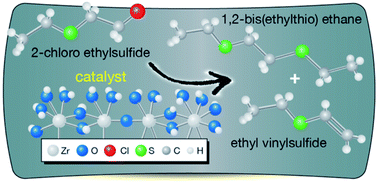Reactive adsorption of mustard gas surrogate on zirconium (hydr)oxide/graphite oxide composites: the role of surface and chemical features†
Abstract
Zirconium (hydr)oxide and its composites with various amounts of graphite oxide (GO) were successfully synthesized using a controlled rate precipitation method. This economically feasible and a quick aqueous synthetic route, which is also suitable for large-scale production, leads to the amorphous materials of a complex texture, relatively large surface area, and high hydroxyl group density. Extensive surface characterization with various chemical and physical methods revealed significant differences in the surface features. The addition of the GO phase increased the surface chemical and structural heterogeneity. The composites were evaluated as reactive adsorbents of mustard gas surrogate, 2-chloroethyl ethyl sulfide (CEES). They showed higher adsorption capacities than those measured on zirconium (hydr)oxide. The results indicated the paramount role of the porosity and surface chemistry in the reactive adsorption process. The GO addition enhances both these features by promoting a high dispersion of the inorganic phase around the carbonaceous phase. 5% GO in the composites was found to be an optimum amount, since it increases the surface area and the number of terminal hydroxyl groups. While the former increased from 208 m2 g−1 for pure zirconium (hydr)oxide to 269 m2 g−1 for the best composite, for the latter a 141% increase was noticed. Moreover, the maximum weight uptakes for zirconium (hydr)oxide and the composite with 5% carbonaceous phase were 106 and 205 mg g−1, respectively. Two general CEES adsorption pathways were proposed. The first one is the retention of organic molecules by physical forces, and the second – the catalytic and selective transformation of CEES to ethyl vinyl sulfide by dehydrohalogenation, and the transformation to 1,2-bis(ethylthio)ethane by polymerization.


 Please wait while we load your content...
Please wait while we load your content...